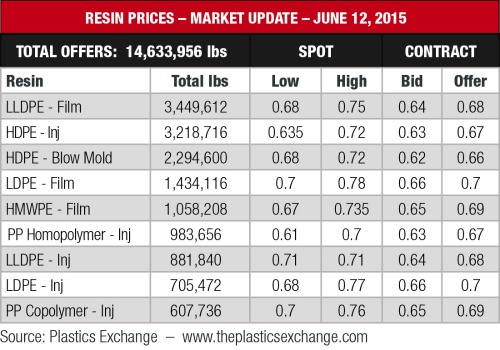
Natural gas and West Texas Intermediate (WTI) crude oil continued to show slight improvements the second week of June, but NGL prices failed to follow a similar path as they fell across the board. The lone NGL to show any strength was once again C5+ due to its close relationship to crude. However, these gains were marginal at only 1% at Mont Belvieu and 2% at Conway.
While crude has improved over the last month and OPEC officials cited these improvements as signs that the market is rebalancing, Barclays Capital stated these could be false winds as OPEC doesn’t have a way to handle additional supplies from Iran and Iraq.
“Saudi oil minister Ali al-Naimi summed up the mood prior to the meeting when he said, ‘Demand is picking up…supply is slowing…it is going in the right direction.’ In fact, the bulk of incoming oil supply and demand data fail to support that view. A more accurate verdict on the data, in our opinion, would be ‘demand is not picking up very much, supply growth has barely slowed at all and things are still heading in the wrong direction for OPEC,’ ” the investment firm said in a June 8 research note.
Though fundamentals may be a bit weak for Brent crude prices, WTI crude improvements are strong due to tighter balances in Canada and West Texas while storage levels are declining at the Cushing, Okla., hub and in the Rockies, according to PIRA Energy Group.
One thing that will be interesting to follow is whether the recoupling between WTI crude and NGL prices will continue if crude prices keep growing. Thus far, the theoretical NGL bbl has begun to trend downward as the WTI bbl has improved. The silver lining to such movements is that a focus on crude production will help tighten the NGL and gas markets, which will eventually help drive up prices.



In the meantime the NGL that makes up the bulk of the theoretical NGL bbl, ethane, does not have a great outlook in the short term. The price plateaued at around the 20 cents per gallon (/gal) mark at Mont Belvieu and has fallen below this threshold for the last three weeks.
“We don’t have a lot of material demand coming online for ethane,” Kendall Puig, senior energy analyst with Bentek Energy, told Midstream Business at Platts’ Benposium. “We imagine ethane prices will be close to the natural gas equivalent floor,” she said while noting there is some room for improvement in the Northeast due to exports coming online in the second-half of this year. Puig said that until more ethane crackers are brought online in late 2017 and early 2018, prices are unlikely to have much upward potential.
Instead the industry’s policy of ethane rejection is likely to continue, especially in regions further away from markets such as the Williston Basin. “Essentially all of the ethane being produced in North Dakota is being rejected with the exception of some production on the Vantage Pipeline going up to Western Canada,” she said.
The news is worse for propane, which hit new 13-year lows at both hubs as the Mont Belvieu price fell 8% to 37 cents/gal and the Conway price dropped 15% to 32 cents/gal. It is very possible that prices could tumble further throughout the summer and into the winter heating season as storage levels are approaching record levels. There is the possibility that as prices creep downward that LPG exports could grow, but so far solid export levels have not had a positive impact on the market.
The theoretical NGL bbl was down 4% to $18.28/bbl with an 18% decline in margin to $8.53/bbl at Conway and 3% to $19.73/bbl with a 14% decline in margin to $9.35/bbl.
The most profitable NGL to make at both hubs was C5+ at 92 cents/gal at Conway and 93 cents/gal at Mont Belvieu. This was followed, in order, by isobutane at 23 cents/gal at Conway and 26 cents/gal at Mont Belvieu; butane at 19 cents/gal at Conway and 23 cents/gal at Mont Belvieu; propane at 7 cents/gal at Conway and 11 cents/gal at Mont Belvieu; and ethane at negative 3 cents/gal at Conway and negative 1 cent/gal at Mont Belvieu.
The U.S. Energy Information Administration reported that natural gas storage levels rose by 111 billion cubic feet to 2.344 trillion cubic feet (Tcf) the week of June 5 from 2.233 Tcf the previous week. This was 47% greater than the 1.591 Tcf posted last year at the same time and 2% greater than the five-year average of 2.3 Tcf. Cooling demand should be up this coming week as the National Weather Service’s forecast anticipates warmer-than-normal temperatures throughout the country.
Recommended Reading
APA, Palantir Expand Partnership to Deploy New AI Across E&P Operations
2024-09-25 - APA Corp. will introduce new AI capabilities to its oil and gas operations with Palantir Technologies’ Artificial Intelligence Platform (AIP) software.
EnerMech Secures Contract with Major North Sea Operator
2024-11-13 - EnerMech will monitor the condition of the U.K. assets in accordance with safety and operational standards.
2024 E&P Meritorious Engineering Awards for Innovation
2024-11-12 - Hart Energy’s MEA program highlights new products and technologies demonstrating innovations in concept, design and application.
HNR Increases Permian Efficiencies with Automation Rollout
2024-09-13 - Upon completion of a pilot test of the new application, the technology will be rolled out to the rest of HNR Acquisition Corp.’s field operators.
Adionics Unveils Lithium Extraction Technology For Recycled Batteries
2024-09-09 - The Paris-based company said its liquid-liquid process achieved lithium recoveries of up to 98% across a range of brine concentrations.
Comments
Add new comment
This conversation is moderated according to Hart Energy community rules. Please read the rules before joining the discussion. If you’re experiencing any technical problems, please contact our customer care team.





